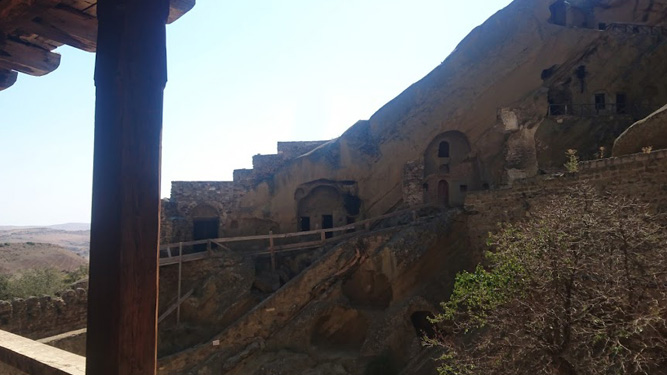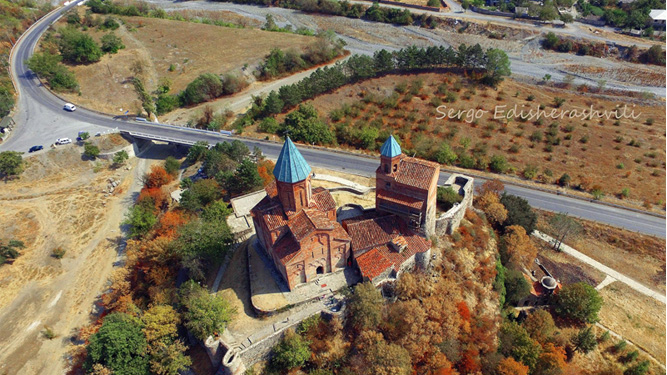
Kakheti
WELCOME TO KAKHETI
Dynamic and historic, Kakheti is the richest wine-making region of Georgia, inhabited by hospitable and openhearted people who live surrounded by high rugged mountains, ancient castles, and magnificent churches. Kakheti is unquestionably a must see for any visitor of Georgia, marrying hospitality and dramatic landscapes, guarantee an unforgettable experience. If the mountains are the crown of Georgia’s superb landscape, then Kakheti is its glowing heart. Winemaking in Kakheti can be traced back several thousand years. Archaeologists have discovered remains dating back to the 6th Century BC that show that Georgia is almost certainly the cradle of wine. Today, over 500 varieties of grape are grown in Georgia and the ancient Kakhetian method of producing wine is still practicedthe juice is kept in a huge clay jar called Qvevri, buried under the ground. And once you taste it, you’ll understand why this delicious, unfiltered, organic wine is so popular. Wine tastings tours and accommodation are available at many of the local-vineyards.
ADVENTURE
Kakheti is one of the most-beautiful and diverse areas of Georgia. Its stunning landscapes include the snow-covered Caucasus mountains, with peaks reaching up to 4,500m, next to the incredibly fertile valleys, fields, and even semi-desert areas of Dedoplistskaro and Sagarejo. With such a variety of climates, altitudes, and landscapes it’s perfect for hiking, biking, and trekking.
KEY PLACES
Tusheti
The fascinating and exclusive area of Tusheti is hidden away in the Caucasus mountains along Kakheti’s northern border with Russia. The Abano Pass is only open from mid-June to early October and travelers should expect the unexpected as they wind their way between the steep cliffs. Tusheti has truly unique cultural heritage, and locals still practice their own form of Orthodox Christianity. Shale stone towers dot the landscape and mark the ancient sites of ritual animal sacrifices. You will gain a deeper insight into the Tusheti culture by spending a night in a local homestays.
Davit Gareja
Gareja is one of the largest monastery complex in Georgia, where famous historical figures lived and worked in ancient times. Built between the 6-17th Centuries, the monastery is even more remarkable for being carved entirely in the rock. It was once a Royal monastery and the churches represent almost the entire range of architectural and artistic styles from the 6th century onwards, while its original frescos are equally stunning.
Bodbe Monastery
Bodbe Monastery dates back to the 4th-9th century. This is where St. Nino, the enlightener of all Georgians died and is buried. Bodbe has always been an important religious and educational centre and had a significant role in the political life of the country and managed to retain its importance as a spiritual centre in the Caucasus for over thousand years.
Gremi Monastery Complex
The magnificent town of Gremi was briefly the capital-of-Kakheti and has equally splendid architecture and history including its church, the royal residence and the commercial neighbourhood. The Archangel Church, built in 1565, is considered as one of the masterpieces of late medieval Kakhetian architecture.
Nekresi Monastery
The town of Nekresi was founded by King Parnajom in the 2nd century BC. In the 4th century AD King Trdat built a church in the town, which is now one of the oldest Christian churches in Georgia. Nekresi was an important spiritual, educational, cultural, and political centre.
Akhali (New) Shuamta
Temple According to the legend, this temple was built when Lord Gurieli’s young daughter Tinatin dreamed that she would marry the prince in whose farmstead she would find a white cornel tree. In return she would have to build a Holy Virgin church there. Later, Tinatin’s dream came true and she married King Levan of Kakheti. In return she did indeed build this temple, and she was eventually buried here.
Alaverdi Monastery
Alaverdi monastery was founded in the second half of the 6th century by Assyrian Father Ioseb from Alaverdi who is buried in the Monastery. Alaverdi St. George Cathedral was built by Kakhetian King Kvirike in the 11th century. The cathedral has retained remains of artwork of the 11th and 15-16th centuries. The cathedral was damaged in battles and was first restored in 1476- 95; In 1742 a strong earthquake destroyed the dome – Queen Tamar initiated the restoration project that was concluded by her offspring King Erekle II in 1750.
Gurjaani Kvelatsminda Church
Gurjaani Kvelatsminda is a wonderful example of a transitional period in Georgian-culture. This 8th century church of the Dormition of the Virgin Mary is the only two-domed temple in Georgia. It was also the scene of a miracle, attributed to the Virgin Mary where milk was found to pour from its bare walls. As a result it was frequently visited by nursing mothers. The pilgrims usually returned home once again able to feed their children.
Tsinandali Museum
Built in the early 19th century by the Chavchavadze family, the Tsinandali estate is encircled by well-maintained gardens and rare trees not found elsewhere in Georgia. The house itself has been converted into a museum honouring the poet Alexander Chavchavadze, leader of Georgian romanticism. Behind the museum, there is the famous Tsinandali wine cellar . You can taste wine on the ground floor of the Chavchavadze Palace.
Vashlovani-Protected-Area
Vashlovani Protected Area is located between the two main rivers of Kakheti – the Iori and Alazani. The gorge is a deep and beautiful canyon cut by a small ravine through the limestone cliffs. The territories of Vashlovani are distinguished with rare wild pistachio trees, arid light forests, and bluestem-feather grass steppes. Georgia’s most unexplored area, Vashlovani’s arid steppe contains incredible wildlife that has adapted to this unique climate. Vashlovani is a destination for the true adventurer and is best explored on horseback.
Lagodekhi-Protected-Areas
One of the first National Parks in the entire Caucasus, Lagodekhi is a wild, untamed area rich with biodiversity. A feast for nature lovers, it has preserved forests, glacial lakes, waterfalls, deep valleys, and access to a wide variety of Kakheti’s wildlife. The largest glacial lake is the Black Cliff Lake, which is 14m deep, and is located on the Georgian – Russian border. If you want to reach St. Nino’s gorge, home to the spectacular Gurgeniani Waterfall, then allow for a 2-3 day hike, but nearly every corner of the park reveals new stunning scenery. Those less adventurous can read all about the history of the park in the Lagodekhi National Park Museum.
Tusheti-National-Park
One of the most ecologically unspoiled regions in the Caucasus, Tusheti is a popular mountain destination. With its snowy peaks, unique pine forests, and deep rivers, old villages, and castles, Tusheti has always attracted visitors, ethnographers, biologists, photographers, and adventure-lovers alike. With mountains reaching up to 4,800m the park embraces alpine meadows, glaciers, rivers, well-preserved pine forests, and all-year round snow-capped peaks.
Telavi
Telavi is home of several of the region’s world-famous wineries, art museums, castles, and a theatre highlighting folk singing and dancing. Telavi is located on the crossroad of the region and is an ideal place to stop for a lunch or an excellent jumping-off point for two or three-day-excursions.
King’s castle
Kig’s Castle is located in Telavi and served as the main residence of the Kakhetian Kings in the 17th-18th centuries. The castle has two churches, the ruins of the royal baths, the pantheon, and the Persian-style Palace of King Erekle II. The Palace now houses King Erekle’s House-Museum. The Ethnographic Museum and the Picture Gallery located within the walls of King’s castle.
Sighnaghi
The name of the town comes from Turkish word “Signak” meaning a shelter and has had a rich history as a centre for tradesmen and artisans. The winding cobblestone streets, Italian architecture, and 18th century defensive walls create a charming atmosphere. Down the hill from the main town there are several historic churches. Stay the night and enjoy the hospitality of the innkeepers and restaurateurs.
Sighnaghi Museum
Sighnaghi museum displays many archaeological, ethnographical, and medieval exhibits and artefacts including musical instruments, weapons, clothes, and many other historical items of everyday life. The most remarkable exhibition presents the paintings of Niko Pirosmanashvili, the greatest Georgian self-taught artist of the 19th century.
Kvareli
Kvareli is a quaint town situated in the middle of the Alazani River Plain and is famous as the home of renowned Georgian writer Ilia Chavchavadze. Kvareli is famous for the delicious, semi-sweet Kindzmarauli-wine. Just a short drive away is a magnificent Ilia lake which is well worth a visit.
Ilia-Chavchavadze-House-Museum
The museum encompasses the family tower and the residential house of the Chavchavadze family, also an exhibition hall, a lecture hall, an archive fund, and the works displaying Chavchavadze’s life (1837-1907). The museum is surrounded by a picturesque garden.
©Georgian National Tourism Administration












